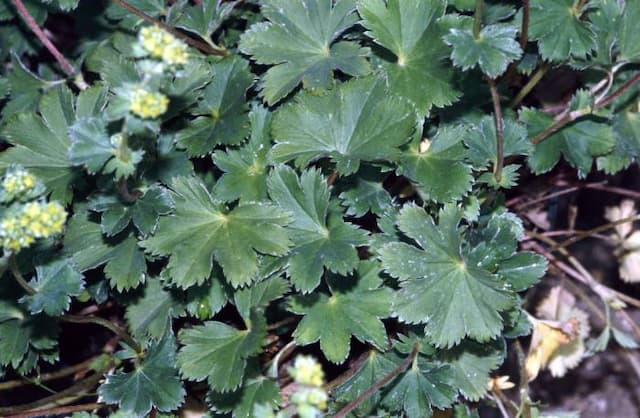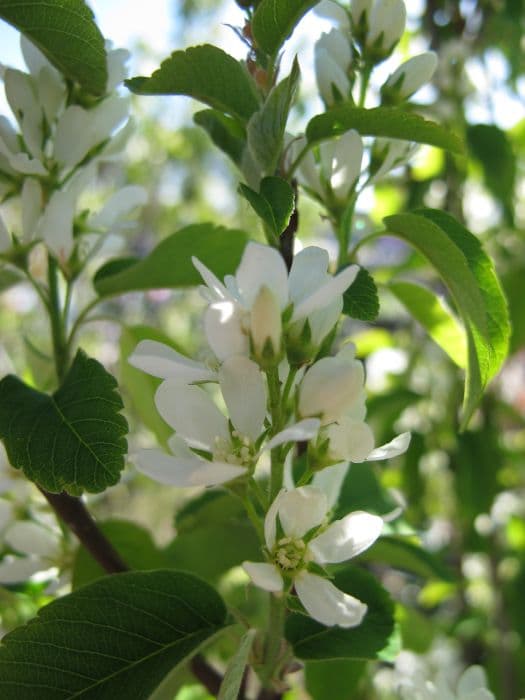Tansy-leaved Thorn Crataegus tanacetifolia

ABOUT
Crataegus tanacetifolia, commonly known as the Tansy-leaved Thorn, is a deciduous shrub that boasts a dense, spreading habit. Its most striking feature is its foliage, which resembles that of the tansy plant with deeply cut, lobed leaves that provide an attractive, fern-like texture to the landscape. The leaves generally bear a rich green hue that transitions to lovely shades of yellow and orange come fall, signaling the changing seasons. During the spring, the Tansy-leaved Thorn comes alive with a profusion of white flowers. These blossoms are small but numerous, covering the shrub in clusters that create a stunning contrast against the green backdrop of the leaves. The flowers exude a subtle fragrance that adds a sensory appeal, attracting pollinators such as bees and butterflies to the garden. As the seasons progress, the flowers give way to fruit, known as haws, which are typically red or reddish-orange. These small, berry-like fruits persist into the winter, providing a source of food for birds and other wildlife during the barren months. The fruit also adds a decorative touch to the winter landscape, standing out against the bare branches after the leaves have fallen. The overall aesthetic of the Tansy-leaved Thorn is one of rustic charm, with its thorny branches and rugged appearance. It lends itself well to naturalistic plantings and can act as a focal point or a supportive background plant in garden designs. Despite being ornamental, the thorny nature of the branches means it can also serve a practical purpose as a barrier or hedge, providing both security and beauty in a landscape setting.
About this plant
 Names
NamesFamily
Rosaceae
Synonyms
Tansy-leaved Thorn, Tansy Hawthorn
Common names
Crataegus tanacetifolia
 Toxicity
ToxicityTo humans
Crataegus tanacetifolia, commonly known as Tansy-leaved Thorn, is not typically considered toxic to humans. There is no significant toxicity reported for the ingestion of this plant, which is a member of the Rosaceae family. Most Crataegus species, including this one, are used for their medicinal and edible properties, such as making hawthorn tea or using the berries in various culinary dishes. As with all plants, individual allergies and reactions are possible, but widespread toxic effects are not documented.
To pets
The Tansy-leaved Thorn, or Crataegus tanacetifolia, is not specifically listed as toxic to pets. The Hawthorn genus, to which this plant belongs, is generally regarded as safe when it comes to pet consumption. However, the ingestion of large quantities of hawthorn berries or plant material may pose a risk of gastrointestinal upset in some animals, such as dogs and cats, as with the ingestion of any non-food item. Monitoring your pet for any sign of distress after ingestion and consulting with a veterinarian if any symptoms appear is advisable.
 Characteristics
CharacteristicsLife cycle
Perennials
Foliage type
Deciduous
Color of leaves
Green
Flower color
White
Height
15-20 feet [4.5-6 meters]
Spread
15-20 feet [4.5-6 meters]
Plant type
Tree
Hardiness zones
4-7
Native area
Turkey
Benefits
 General Benefits
General Benefits- Ornamental value: Crataegus tanacetifolia, commonly known as Tansy-leaved Thorn, has attractive foliage and beautiful flowers that add aesthetic appeal to gardens and landscapes.
- Wildlife habitat: The Tansy-leaved Thorn provides a habitat and food source for various species of birds and insects, contributing to biodiversity.
- Drought resistance: Being naturally adaptable to dry conditions, the Tansy-leaved Thorn can thrive in areas with low water availability, making it suitable for xeriscaping.
- Seasonal interest: This plant offers visual interest throughout the year with its spring blooms, summer foliage, autumn fruit, and winter structural form.
- Soil stabilization: The root system of the Tansy-leaved Thorn helps to prevent soil erosion, especially in sloped areas or where ground cover is needed.
- Low maintenance: Once established, the Tansy-leaved Thorn requires minimal care, making it an easy addition for both novice and experienced gardeners.
 Medical Properties
Medical Properties- Cardiotonic: Crataegus tanacetifolia may have effects that strengthen heart function.
- Antioxidant: It could possess compounds that help in reducing oxidative stress.
- Anti-inflammatory: Some components may have the ability to reduce inflammation.
- Antihypertensive: There might be blood-pressure-lowering effects associated with its constituents.
 Air-purifying Qualities
Air-purifying QualitiesThis plant is not specifically known for air purifying qualities.
 Other Uses
Other Uses- Crataegus tanacetifolia, commonly known as Tansy-leaved Thorn, can be utilized as a natural dye source, with different parts of the plant yielding various shades on wool or fabric.
- The durable wood of Tansy-leaved Thorn is sometimes used in the crafting of small wooden items such as tool handles or intricate carvings.
- Its dense and thorny nature makes it an effective hedging plant for those seeking a natural and impenetrable barrier against wildlife or intruders.
- In landscape design, Tansy-leaved Thorn can be used as a focal point plant for its attractive foliage and blossoms.
- Due to its interesting leaf shape, the plant can be employed in botanical art and illustration for educational or artistic purposes.
- The thorns of Tansy-leaved Thorn can be collected and used in natural remedies for external application on skin, not related to their medicinal properties, but as a physical barrier for warts or calluses.
- Florists may use the branches of Tansy-leaved Thorn for their structural qualities in creating complex flower arrangements.
- Hobbyists might use the fallen leaves of the plant for creating eco-friendly print patterns on fabrics or paper in craft projects.
- Tansy-leaved Thorn can serve as a shelter plant for beneficial insects, providing a haven that can indirectly help maintain the ecological balance of a garden.
- The plant's bright berries can be used as a natural food coloring for crafting materials, though they are not recommended for consumption.
Interesting Facts
 Feng Shui
Feng ShuiThe Tansy-leaved Thorn is not used in Feng Shui practice.
 Zodiac Sign Compitability
Zodiac Sign CompitabilityThe Tansy-leaved Thorn is not used in astrology practice.
 Plant Symbolism
Plant Symbolism- Hope: Crataegus tanacetifolia, commonly known as Tansy-leaved Thorn, is often associated with hope. The thorn part of its name suggests resilience and endurance, which complement the idea of hope persisting through hardships.
- Protection: Thorns on the Tansy-leaved Thorn have historically been seen as a natural barrier, symbolizing protection against negative forces and energies.
- Love and Marriage: In some cultures, the Tansy-leaved Thorn is connected to concepts of love and marriage, possibly due to the plant's hardiness, reflecting the strength and endurance required in a committed relationship.
- Cleansing: Its association with the herb tansy, which was used for its purifying qualities, gives the Tansy-leaved Thorn connotations of cleansing and renewal.
 Water
WaterTansy-leaved thorn requires regular watering to establish a strong root system, especially during its first growing season. Water the tree deeply once a week, providing about 15 to 20 gallons of water each time, depending on soil conditions and rainfall. During hot, dry periods, monitor the soil moisture and water more frequently if the top few inches of soil feel dry to the touch. Reduce watering during the fall and winter when the tree is dormant. Overwatering can lead to root rot, so ensure good drainage and allow the soil to dry slightly between watering sessions.
 Light
LightTansy-leaved thorn thrives best in full sun to partial shade. Ideally, plant it in a location where it receives at least 6 hours of direct sunlight each day to encourage healthy growth and ample flowering. Avoid deeply shaded areas, which can lead to poor plant health and reduced flowering.
 Temperature
TemperatureTansy-leaved thorn grows well in a range of temperatures but prefers a temperate climate. It can tolerate temperatures down to about -20°F, making it suitable for USDA hardiness zones 4 through 8. The ideal temperature range for this plant is between 65°F and 75°F during the growing season.
 Pruning
PruningPrune the tansy-leaved thorn to maintain its shape and health. Pruning is best done in late winter or early spring before the sap starts to flow and new growth begins. Remove any dead, damaged, or diseased branches, and thin out crowded areas to improve air circulation. Pruning can be done annually or as needed to control the tree's size and shape.
 Cleaning
CleaningNot needed
 Soil
SoilTansy-leaved thorn (Crataegus tanacetifolia) thrives in well-draining soil with a pH range of 6.0 to 7.5. An ideal soil mix for this plant would include loamy soil, peat, and coarse sand or perlite to ensure good drainage. Organic matter such as compost or well-rotted manure can also be added to provide nutrients.
 Repotting
RepottingTansy-leaved thorn (Crataegus tanacetifolia) typically does not require frequent repotting. Repot young trees every 2-3 years, while mature plants may only need to be repotted every 4-5 years or if they show signs of being root-bound.
 Humidity & Misting
Humidity & MistingTansy-leaved thorn (Crataegus tanacetifolia) is adaptable to a range of humidity conditions and does not require any special humidity considerations. It is capable of thriving in the ambient outdoor humidity levels in most temperate regions.
 Suitable locations
Suitable locationsIndoor
Place in bright, indirect light with some direct sun.
Outdoor
Plant in sun or partial shade, shelter from strong winds.
Hardiness zone
4-8 USDA
 Life cycle
Life cycleCrataegus tanacetifolia, commonly known as Tansy-leaved Thorn, begins its life cycle as a seed, which germinates in suitable soil conditions, typically requiring some period of cold stratification to break dormancy. After germination, the seedling emerges and develops into a young plant, establishing a root system and producing leaves in its first growing season. As it reaches the juvenile stage, the plant grows rapidly and begins developing woody stems; this phase can last for several years as the Tansy-leaved Thorn matures. Upon reaching maturity, it starts to produce flowers, usually white with five petals, often in clusters, which are pollinated by insects, leading to the development of fruit – small dark red berries called haws. These berries are then dispersed by birds and other animals, ensuring the propagation of the species. After many years, the Tansy-leaved Thorn will reach the end of its life cycle, dying back to provide nutrients to the soil and space for new plants.
 Propogation
PropogationPropogation time
Spring-Early Summer
The most popular method of propagation for the Crataegus tanacetifolia, commonly known as Tansy-leaved Thorn, is by seed sowing. Seeds can be collected from ripe fruits and they typically require a period of cold stratification to break dormancy. This involves mixing the seeds with slightly moist sand and storing them in a refrigerator at about 34°F to 40°F (1°C to 4°C) for approximately 1 to 3 months. After stratification, the seeds are sown in a well-draining soil mix, lightly covered with soil, and kept at a temperature of about 70°F (21°C). Germination may be slow and irregular, but once seedlings emerge, they should be grown on in cooler conditions until they are strong enough to be planted out.









